|
|
Post by dodgehemi on Nov 28, 2009 9:40:45 GMT -5
|
|
|
|
Post by dodgehemi on Nov 29, 2009 18:14:14 GMT -5
|
|
|
|
Post by dodgehemi on Nov 30, 2009 15:10:05 GMT -5
This Might be Good Part One  Evolution of the stock car: Part I February 6, 2002 11:12 PM EST (0412 GMT) Throughout the 53-year history of NASCAR, its race cars have been transformed from road-going, lumbering true "stock" cars into the sleek, technologically advanced machines that we see today on ultra-modern speedways. In tracing the evolution of the cars that we know today as the Winston Cup Series, it's necessary to go back to the beginnings of NASCAR and its "Strictly Stock Division." It all started with races on the famed Daytona beach/road course in the late 1940's. When NASCAR was formed in 1948, there was a definite shortage of new cars in the post-war era. The feeling was that race fans wouldn't stand for new cars being beat up on a race track while they were driving a rattletrap pre-war automobile, so "Modified" cars were the early staple of NASCAR racing. However, in 1949, NASCAR president Bill France Sr. re-visited the idea of racing the cars that people actually drove on the street -- late model family sedans. Since no other racing organization had seized the idea, France figured it might take root and create added interest. The success of the modern Winston Cup Series proves he was correct. From the racers' perspective, putting a race car together was not a high-dollar deal. If a brand-new Buick sold for about $4,000, due to the lack of modification that could be done to it, the car could be raced for very little more of an investment. In some instances, rental cars were actually used as race cars by point-chasing drivers who had no locked-in "ride" for an event. Cars were typically either driven to the track or "flat-towed" behind pick-ups and family sedans. Other than tweaking and tuning of the engine, nothing could be done to these early Strictly Stock cars. The window glass front, back and sides was intact. Ropes and aircraft harnesses were used as seat belts. Roll bars -- which were mandated in 1952 -- were neither required nor often installed. One thing the strictly stock designation encouraged was a great diversity of manufacturers on the track. The first official Strictly Stock Division race had nine makes come to the line, including Buick, Cadillac, Chrysler, Ford, Hudson, Kaiser, Lincoln, Mercury and Oldsmobile. Some of the biggest problems were tire; wheel and suspension failures brought on by stresses that were atypical of normal road use. These concerns brought about novel solutions such as one detailed by two-time Grand National (forerunner of Winston Cup) champion Tim Flock, who described a trap door in the floorboard of his race car that he could open with a chain to check right front tire wear. "When the white cord was showing, we had about one or two laps left before the tire would blow," said Flock of the 'early-warning system.' Due to the rough-surfaced dirt tracks that were predominant in the early days of the sport, the only modification that was allowed was a reinforcing steel plate on the right front wheel to prevent lug nuts from pulling through the rims on conventional wheels. Otherwise, racing stock cars in the early days of the sport was very much a seat of the pants endeavor. But it was one that spawned innumerable legends of drivers who created them, literally, with their own hands, feet and indomitable wills and courage. |
|
|
|
Post by dodgehemi on Nov 30, 2009 15:15:43 GMT -5
PART Two
Evolution of a stock car: Part II
February 6, 2002
11:11 PM EST (0411 GMT)
It all started with races on the famed Daytona beach/road course in the late 1940's. Throughout the 53-year history of NASCAR, its race cars have been transformed from road-going, lumbering true "stock" cars into the sleek, technologically advanced machines that we see today on ultra-modern speedways. In tracing the evolution of the cars that we know today as the Winston Cup Series, it's necessary to go back to the beginnings of NASCAR and its "Strictly Stock Division."
For a certain number of years, that concept certainly worked and, through the support of fans, competitors and manufacturers, it continued to thrive. But the variety of race tracks in use and the intensity of the competition level necessitated various modifications. While many of these were instituted "in the interest of safety," manufacturers found that there were ways to integrate "high performance" parts and pieces into their mainstream production line, thereby making these "hot" parts eligible for use in Grand National racing, the forerunner of the Winston Cup Series.
One of the first items produced specifically for stock car racing was a racing tire manufactured and distributed by the Pure Oil Company in 1952. Prior to that time, street tires were all that were available for racing applications.
Not everything that was developed through this period was an integral part of the cars themselves. Two-way radios were first used in a NASCAR race at the 1952 Modified-Sportsman race on the beach/road course at Daytona Beach, Fla. Their use developed until they became an indispensable piece of equipment on a Grand National race car.
In the early 1950s roll cages also made more of a widespread appearance. Tim Flock won the 1952 Modified-Sportsman race in Daytona Beach, but was disqualified due to his roll cage being made of wood. Although some novel uses of bed frames and other iron devices were created for roll bars, their use stiffened race car chassis and improved cars' performance.
One of the first major changes in race car development came in 1953, when the Oldsmobile, Lincoln and Hudson car companies introduced "severe usage" kits, primarily composed of suspension parts, in response to an alarming spate of failures to spindles, hubs, axles and other suspension pieces.
The manufacturers were also discovering that they could introduce high performance options in their street cars that would make them eligible for the race track. Hudson's "Twin H" carburetor setup was one such tweak that Hudson drivers used to win 22 of 37 races in 1953.
In 1955, Chevrolet and Ford, mirroring their intense spirit of competition that's displayed in 2001, also had factory-backed programs. But it was Chevrolet's introduction of the 355-cubic inch "small block" V8 engine that was one of the most significant developments in the history of stock car racing. That engine, with very minor changes, is still in use by General Motors race teams across the country in most racing series.
Through this period, Marshall Teague of Daytona Beach, one of racing's true innovators who was largely credited with bringing the Hudson Motor Car Company and Pure Oil into racing, pioneered the use of Chevrolet truck spindles and suspension parts when he was competing in AAA stock car racing. The giveaway that a car was running the heavier axles and beefier suspension components was a six-lugged wheel, not the typical five-lugged version.
Buick unveiled a major coup in 1957 when it had finned aluminum brake drums on its Buick Roadmaster. The car, made famous by Fireball Roberts, used a braking system that dissipated heat more efficiently due to the use of aluminum and the finned design.
As the decade of the 1950s began to come to close and the superspeedway era was about to dawn; GM made a major change to the frame design of its cars in 1958. It debuted an "x-frame" design with a coil spring rear suspension, departing from the "box frame" with leaf spring rear suspension that was more popular and better understood by the racers.
Consequently, very few 1958 Chevrolets were used; particularly early in the season, as the racers chose to go with what they were familiar with. However, innovative mechanic Henry "Smokey" Yunick had the system figured out and driver Paul Goldsmith won the final beach/road course race, using a 1958 Pontiac with the new design.
The newer setup would prove to be the "hot tip" on the big tracks that would begin to open with the advent of Daytona International Speedway in 1959.
It was the next step in the ongoing evolution of the Winston Cup stock car.
|
|
|
|
Post by dodgehemi on Nov 30, 2009 15:17:42 GMT -5
Part Three
Evolution of a stock car: Part III
February 6, 2002
11:11 PM EST (0411 GMT)
While a "superspeedway boom" occurred from 1959 to the early 1960s, with no less than four major speedways being built in Daytona Beach, Fla.; Hanford, Calif.; Concord, N.C.; and Hampton, Ga.; the automobile manufacturers -- who had signed an agreement that "got them out" of racing in 1957, gradually realized that to sell new cars, it certainly helped to win races.
Despite accruing the knowledge of what it took to win Grand National races, the period was interesting in that both engine and body configurations went through several "generations" and radical changes as race cars, by and large, matched what was pushed in the showrooms by the manufacturers.
One of the most interesting occurrences in 1959 came when the Ford Motor Company abandoned its "top of the line" Galaxy model to use its Thunderbird as the race car of choice. The Galaxy was a fairly bulky car that year, so Holman & Moody, Ford's acknowledged racing arm, built a "fleet" of T-Birds to compete in Grand National racing, the forerunner of the Winston Cup Series.
The T-Bird was lower and sleeker than the Galaxy but it still fell within the dimensional parameters set in the NASCAR rules...even though the car had been created as a "sports car" that was designed to compete with Chevrolet's Corvette.
Although the T-Bird continued to compete, Ford returned to its "premier" Galaxy Starliner model in 1960.
Conventional, full frame cars were still the norm as purpose-built tube frame race cars were still out on the Grand National horizon. Stories of race teams -- as Ray Fox's did in 1960 to win the Daytona 500 -- picking up cars from showrooms only days before races and converting them to race cars were commonplace.
In the General Motors' camp, teams had figured out the coil spring rear suspension setup that was introduced in 1958 and virtually everyone was running the 1959 Chevrolet on the big tracks, where it was particularly effective. This "light bulb" effect certainly led some to believe that the racers must have gotten some suspension geometry help from Detroit, but the manufacturers were still laying pretty low due to the Automobile Manufacturers Association (AMA) agreement that had disassociated them from the sport.
Through this period, of course, innovation often was the answer to necessity, and with many NASCAR races still conducted on dirt tracks and with pavement tracks sometimes coming apart, screens, grillwork and other protective devices were often de rigeur.
The early days found race teams not necessarily locked-into a particular manufacturer's model or even make. They were able to do some amazing things with cars that looked particularly unwieldy to the naked eye: Witness the monstrous Oldsmobile with which Lee Petty won the inaugural Daytona 500, which was a somewhat tank-like ride. Petty jumped back and forth between Chrysler and Oldsmobile in that time, depending on which car was more suited to the task at hand.
As the "superspeedway boom" era continued, manufacturers began to pay more attention to aerodynamics. The 1963 Ford Fastback Galaxy was used in the manufacturer's literature and was advertised as a race car. The 1960-61 Starliner had what was actually an effectively aerodynamic roofline. In fact, with the 1962 car a pretty boxy proposition, Fred Lorenzen ran a 1962 Galaxy with a 1961 Ford roof in a one-shot deal for the Atlanta 500 -- and won the race in the car's only appearance.
General Motors had a grip on the Grand National championship in the early 1960s, with Rex White and Ned Jarrett winning titles in 1960-1961 in Chevrolets and Joe Weatherly copping the titles in 1962-1963 -- primarily in Pontiacs. In the 1961-1962 season Pontiac won more races than any manufacturer in the history of the Grand National Division in consecutive years: 52.
Mercury added a twist to the manufacturers' battle when it entered racing in a bigger way in 1963 with its Marauder model. Bill Stroppe, the West Coast's answer to Holman & Moody, handled the Mercury competition program with a similar assembly line approach. Unknown newcomer Billy Wade swept four straight races in 1964 driving a Mercury.
Mercury prompted the switch of legendary NASCAR car owner Bud Moore to the Ford Motor Co. camp when Moore -- in the absence of significant support from General Motors -- switched from Pontiac to Mercury. Weatherly took the 1963 championship but had to pick-up rides for most of the year. Ford scored another coup when it grabbed Fireball Roberts, who won his first race for Ford in 1963 at Bristol (Tenn.) Motor Speedway. The swapping of personnel is one part of stock car evolution that has been around since the beginning.
Shock development, which today is acknowledged as critical to race car performance, also experienced more emphasis in the early 1960s. The popular "Air Lift" shocks were being phased out and Monroe and Gabriel became heavily involved in shock development for racing applications.
Tire development also continued. Firestone was the dominant tire company, but Goodyear was involved to a limited degree. Increasing speeds made these developments important.
The end of this period also brought an end to one unique item. Through the early 1960s, Lorenzen still used a trap door in the driver's compartment to check tire wear. By 1965, however, nobody used the device that was once a favorite of dirt track competitors.
Another significant advance during this period occurred as roll cage structures began to become a more integral part of the car and as such, were used to stiffen the chassis and improve a car's handling as well as serving as vital protection.
A variety of triangulated bars, from front to back, across the mid-section of the car and also in the doors were as much to stiffen and strengthen the cars as they were to serve as protection. There was a tremendous amount of flex inherent in the "x-frame" cars used in the 1958-60 period. Smokey Yunick was one of the first car builders to use the roll cage as an integral part of the car's chassis.
Ford had unleashed the flow of relatively open factory support when it repudiated the AMA agreement in 1962. While General Motors remained mostly silent, within a few weeks Chrysler announced it would develop "high performance" parts for stock car racing.
Another big issue of this period was in the engine compartment.
Noted mechanic Fox was the mastermind behind Chevrolet's so-called "mystery engine," a 427-cubic inch "high lift" high performance piece that would replace the 409-cubic inch engine that was often referred to as a "boat anchor" because of its weight. Yunick, the other half of the legendary mechanical pair that lived in Daytona Beach, was also involved in the development of that engine.
While much of the mystique of this engine was as much hype as it was fact, at the time Ford claimed it spent $1 million chasing the development curve on Chevy's powerplant. Junior Johnson, driving Fox's 1963 Chevrolet, sat on a lot of front rows with the combination, but as had often been the case with other potent mixes, in most cases the car was either a top-5 finisher or it broke.
Among the team's accomplishments in 1963 was sweeping the front row for the Firecracker 400 at Daytona International Speedway, with Johnson and G.C. Spencer doing the honors.
The "engine wars" reached a peak when in 1964 Richard Petty brought a Plymouth hemispherical combustion chamber engine, or "hemi," and cleaned house at Daytona, including winning the first of seven Daytona 500s. The Plymouth and Dodge body styles had been streamlined somewhat first. The hemis: Plymouth's "Super-Commando" and Dodge's "Hemi-Charger" now had an appropriate platform in which to sit.
The engine had first been produced in the early 1950s, but had been shelved with the AMA ban in 1956. Chrysler engineers also came up with a double rocker arm system used in conjunction with the hemi heads. This combination, which created a free-breathing combustion chamber, produced a good bit of top end horsepower, particularly on high-speed facilities.
Ford came back with its "tunnel port" 427-cubic inch engine. And Ford had a very well handling race car. Following the Daytona 500, the fourth point race of the season, Ford won 11 out of the next 15 races -- 13 of which were on short tracks. Plymouth and Dodge won two races apiece in that stretch.
As was the case in many other aspects of racing, NASCAR kept a close eye on these developments and took action, as it became necessary. The repercussions from that highlighted the next period in the evolution of a stock car.
|
|
|
|
Post by dodgehemi on Nov 30, 2009 16:47:36 GMT -5
Alan Kwicki
Like the burning embers of a campfire rising into the evening sky,Phoenix International Raceway will shine brightly when the NASCAR NextelCup Series competes in the first-ever night race at the famed desertoval on Saturday, April 23.
The Subway Fresh 500 will take the greenflag at 7:55 p.m. Eastern Time and will be the 18th Nextel Cup race heldat the track. It will be the first of two Nextel Cup races at the trackthis year and the only one to be run at night.
The historic event isjust the latest chapter in PIR's history, one that dates back toFebruary 1964 when the facility opened with Davey McDonald winning onthe track's road course. A.J. Foyt proved to be the winner of thetrack's first oval track event, a 100-mile Indy Car race later thatyear.
The stock car crowd didn't make it on to the new Phoenix racingsurface until January 1968 when Don White captured a 250-mile event onthe road course. It took 20 years for NASCAR's Cup division to returnthe desert oval raceway with the running of the Checker 500 in 1988.Long a hot bed of racing, NASCAR's top division had competed at the oldArizona State Fairgrounds track in the 1950s with top stars Buck Baker,Marshall Teague and Tim Flock all winning on the one-mile oval there.
The 1988 PIR event proved to be historic not only for the return ofNASCAR to the Southwest, but also marked the first career NASCAR Cupvictory for Alan Kulwicki.
Kulwicki, a mechanical engineer, apprenticedfor his Cup career on the Wisconsin short tracks and the American SpeedAssociation before running his first Cup event at Richmond, Virginia, inthe fall of 1985.
Kulwicki competed in 5 of 28 Cup events in 1985 andcollected $10,290 for his efforts. His season-best finish--13th--came atCharlotte (now Lowe's) Motor Speedway in the Miller High Life 500.
In1986, Kulwicki gained notoriety for racing hard with significantly lessfunding than most of his competitors. Acting as both team owner anddriver, Kulwicki made it through the season with using basically onecar--the No. 35 Quincy's Steakhouse Ford Thunderbird dubbed "OldSirloin"--and a couple of engines. For his efforts, Kulwicki was namedRookie of the Year in the Cup division.
With more funding in 1987,Kulwicki began to make waves on the Cup tour by winning three poles,including the top spot for both Richmond races. He finished arespectable 15th in the season championship chase and earned $369,889 inprize money.
The 1988 season proved to be Kulwicki's breakthrough year.Driving his own No. 7 Zerex-sponsored Ford Thunderbird, dubbed the"Underbird," Kulwicki scored six Top-5 finishes heading into theinaugural Phoenix Cup event. It seemed like just a matter of time beforethe driven Greenfield, Wisconsin, native would break into the wincolumn.
In qualifying for the 1988 Checker 500, Geoff Bodine proved tobe the class of the field by winning the pole position in his No. 5 LeviGarrett-sponsored Hendrick Motorsports Chevrolet with a lap 123.203miles per hour.
On race day, a crowd estimated at 60,000 looked on asBodine, Kulwicki and 41 other drivers began competing for the first-everCup checkered flag at Phoenix. Kulwicki, who started 21st, was a distantsecond to race leader Ricky Rudd late in the event. Rudd, who dominatedthe race by leading a whopping 183 laps, saw the win slip away when theengine expired in his Kenny Bernstein-owned Buick. That gave Kulwicki,who led a total of 41 laps in the race, the top spot with just 12 lapsremaining.
At the finish, it was Kulwicki by a wide margin--18.5 secondsover Terry Labonte, Davey Allison, Bill Elliott and Rusty Wallace. Theevent was slowed six times for cautions, totaling 52 of the 312 laps.Kulwicki's margin of victory is still the largest in the history of theCup division at Phoenix. Ironically, his winning average speed of 90.457miles per hour is still the slowest in the history of the division atthe track.
Slow or fast, Kulwicki didn't care. After years of trying,the independent driver had won his first Cup race. He celebrated byinitiating the "Polish Victory Lap" in which he circled the track in theopposite direction, window net down, while saluting the fans in theceremonial ritual he would become famous for.
Eventually, Kulwicki wonfive Cup races in his short career. His life ended tragically, though,when his private plane crashed en route to the spring race at Bristol,Tennessee, on April 1, 1993.
In all, Kulwicki competed in 207 Cup eventsand finished in the Top-5 38 times and the Top-10 on 75 occasions.Always a good qualifier, Kulwicki scored 24 poles in his career, six ofthem in his 1992 NASCAR Winston Cup championship-winning season.
SinceKulwicki's win in the inaugural Cup race at Phoenix in 1988, 13 otherdrivers have visited Victory Lane at Phoenix. Included in that group areDavey Allison, Terry Labonte, Rusty Wallace, Ricky Rudd, Elliott, DaleEarnhardt, Dale Jarrett, Jeff Burton, Mark Martin, Tony Stewart, BobbyHamilton, Matt Kenseth and Dale Earnhardt, Jr.
Earnhardt, Jr. etched hisname into the record books last fall when he won the Checker Auto Parts500 at Phoenix International Raceway for the second-straight season. Thetwo victories put Earnhardt, Jr. in the same company as Allison(1991-1992) and Burton (2000-2001) as the only drivers to winback-to-back Cup races at Phoenix.
Earnhardt Jr. started last year'sPhoenix Cup clash from the 14th position and led 118 of the 312circuits. He secured the victory when he roared by Jeff Gordon and intothe lead for good with 11 laps remaining.
Earnhardt collected $274,503for his winning effort, more than two-thirds the $368,630 total pursethat was up for grabs in the first Cup race at Phoenix in 1988. Arace-record 11 cautions slowed the 2004 event for 63 of the 315 lapswith Earnhardt's average winning speed a leisurely 94.848 miles perhour.
Can Earnhardt, Jr. become the first driver to win three Cup racesin a row at Phoenix? If not, who will become the first driver to win aNASCAR Nextel Cup night race at the Phoenix oval?
Whatever the outcomeand despite the glitter and spectacle of the first-ever night race inthe desert, the 2005 Subway Fresh 500 will be hard-pressed to match theexcitement of the 1988 Phoenix Cup event when a hard-working, underdogracer from Wisconsin scored his first NASCAR Cup victory and burned theevent into our racing consciousness forever with his "Polish VictoryLap."
|
|
|
|
Post by dodgehemi on Dec 3, 2009 17:50:51 GMT -5
Question
#1 Who was the last driver to win both races at Darlington Raceway the same year? #2 Name of the 2 races (The Whole name)? #3 Name the Year?
No takers on the answers?
Will give the answer on Saturday Dec. 5, 2009
|
|
|
|
Post by dodgehemi on Dec 4, 2009 13:37:24 GMT -5
Wendell Scott
46 years ago today - Scott wins: Wendell Scott, an African-American driver from Danville, Va., won his first and only NASCAR Grand National (Sprint Cup Series) race at Speedway Park in Jacksonville, Fla. The race distance was 200 laps on the half-mile dirt track and initially Buck Baker was flagged the winner. However, once scoring was re-checked the victory was given to Scott who actually completed 202 laps. Baker was second and Jack Smith third. Between 1961 and 1973, Wendell Scott competed in 495 NASCAR events with 20 top-fives and 147 top-10 finishes. Prior to NASCAR he dominated the short track on the Dixie Circuit and outlaw tracks in Virginia and North Carolina. He won the Virginia State Sportsman title in 1959 after racking up 22 victories. He passed away in 1990.(Around The Track Online)(12-1-2009
|
|
|
|
Post by dodgehemi on Dec 4, 2009 17:43:36 GMT -5
In Line RacingA lot of good Drag Racing took place here on SATURDAY NIGHT AND SUNDAY AFTERNOONDrag
|
|
|
|
Post by dodgehemi on Dec 5, 2009 10:11:58 GMT -5
Answers to the question above.
The Driver was Jimmie Johnson
The 2 Races were
The Carolina Dodge Dealers 400
The Mountain Dew Southern 500
The Year was 2004
|
|
|
|
Post by dodgehemi on Dec 5, 2009 18:48:37 GMT -5
Limited Time Petty Display Daytona Daytona 500 Experience Home To Exclusive Tribute To The King Exhibit Through Dec. 31 While Daytona International Speedway celebrated the 25th anniversary of Richard Petty's historic 200th win during the recent Coke Zero 400 Weekend, the tribute to the "King of stock car racing" and the Petty family continues at Daytona 500 Experience. View Video Here The exclusive Tribute To The King exhibit remains on display at the “Official Attraction of NASCAR” located just outside of Turn 4 at “The World Center of Racing” through Dec. 31. From race-winning Richard Petty cars to the driver’s suit that Petty used to win his historic 200th and final NASCAR race in 1984 400-mile mid-summer classic, race fans will be able to view priceless artifacts documenting a historic racing career. All of the cars and mementos are on loan from the Petty Museum in Level Cross, N.C.. “We’re grateful to Richard Petty and the entire Petty family for assisting us in putting together this exhibit,” Daytona International Speedway President Robin Braig said. “The 'King’ has been enormously generous in loaning some prized treasures from his museum and race fans aren’t going to want to miss the opportunity to view these priceless items.” Among the Petty cars are on display include: • No. 43 Pontiac that Petty drove to win his 199th race at Dover and is a replica of his 200th-winning car (Daytona 500 Experience) • Oldsmobile from Petty’s 1979 Daytona 500 (Daytona 500 Experience) • 1966-67 Plymouth Belvedere, which won 27 races in the 1967 NASCAR season (Daytona 500 Experience) • The No. 43 Buick from Petty's seventh and final Daytona 500 win in 1981 (Daytona 500 Experience ) • 1957 Convertible (Daytona 500 Experience) • Original Mini Cooper (Daytona 500 Experience) • Replica No. 43 car from Petty’s 200th win (Sprint FANZONE) Among the many unique items from the Petty memorabilia collection on display inside the Goodyear Heritage of Daytona inside Daytona 500 Experience include: • Trophy from his victory in the 1984 mid-summer classic • Driver’s uniform and helmet from his 200th win • Green flag from the 1984 July race • Large collection of trophies including all seven Daytona 500s and his 100th NASCAR win • Belt buckles representing his seven NASCAR championships as well as his 1974 and 1979 titles. • Die-casts, racing helmets and photos For more information on Daytona 500 Experience, call Guest Services at (386) 681-6530 or go online at www.DAYTONA500EXPERIENCE.com About Daytona 500 Experience: The Daytona 500 Experience, the official attraction of NASCAR, is a high-energy experience designed to appeal to both hard-core race fans and casual observers. Wall-to-wall activities, challenging thrills and one-of-a-kind sights pack the Ultimate Motorsports Attraction. Included inside the attraction is the Pepsi IMAX Theatre, the 16-Second Pit Stop Challenge, three different motion simulators and the winning Daytona 500 car. Tickets for The Daytona 500 Experience, which includes admission to the attraction as well as the Speedway tour, are $24 plus tax for adults, $19 plus tax for seniors 60 and over and children age 6-12. Children under six are free. 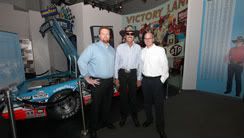 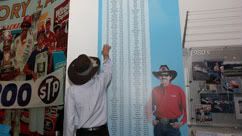 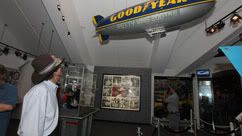  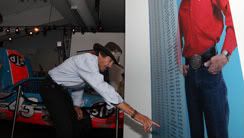 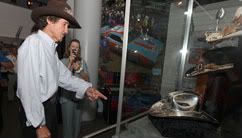 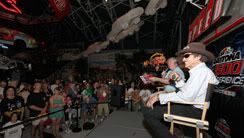 |
|
|
|
Post by dodgehemi on Dec 5, 2009 19:04:00 GMT -5
Richard Petty Driving Experience and Daytona International Speedway Offer Program with "The King" Richard Petty to Host Drivers at the Track Where His Legend Was Made DAYTONA BEACH, FL. October 6, 2009 – Imagine yourself behind the wheel of a 600hp NASCAR-style stock car. Now, imagine that stock car on the legendary high banks of Daytona International Speedway, “The World Center of Racing”, at speeds of up to 160mph. And then imagine this happening in the presence of NASCAR’s all-time winningest driver and 10-time Daytona champion “The King”, Richard Petty. On December 14th, 2009 Richard Petty Driving Experience (RPDE), the world leader in stock car driving and riding experiences, and Daytona International Speedway (DIS) will make this dream a reality for 12 drivers. This select group will take the wheel of an authentic NASCAR-style stock car for 50 high-speed laps around the famed 2.5 mile superspeedway over the course of six adrenaline-filled driving sessions. As if that weren’t thrilling enough, participants will also be given an intimate, once-in-a-lifetime tour of the “Tribute To The King” exhibit at DAYTONA 500 Experience led by Mr. Petty, himself. “Daytona holds great memories for me and I always enjoy returning there”, said Petty. “And, while it’s always cool to see the thrill people get from driving our cars, it’s extra special at this race track. I know this lucky group is going to love it.” “Daytona International Speedway and Richard Petty share a storied history,” Track President Robin Braig said. “This unique opportunity to rub elbows with the Speedway’s all-time Daytona 500 champion and drive on our legendary race track at the same time is taking the race experience to new heights.” The “VIP Experience at Daytona” is available for $6,500.00 per participant. RPDE “Experience Rewards” members will receive a $500.00 discount. For more information or to register for the event, call 1-800-BE-PETTY. The VIP Program will be held on Monday, December 14th, 2009 and is limited to twelve participants. About Richard Petty Driving Experience: Richard Petty Driving Experience, a motorsports entertainment and automotive services company headquartered in Concord, N.C., produces and facilitates NASCAR-style stock car drive and ride-along experiences, auto manufacturer ride and drive programs, safe driving programs, mobile marketing events and production services to the film industry. The company offers rides and drives at more than 20 major speedways and hosted over 100,000 participants in 2008. RPDE has permanent facilities in Las Vegas, Walt Disney World and Concord. For more information, call 1-800-BE-PETTY (1-800-237-3889) or visit www.1800BEPETTY.com About Daytona International Speedway: Daytona International Speedway is “The World Center of Racing” and home to the Daytona 500, the NASCAR Sprint Cup Series’ biggest, richest and most prestigious race. The NASCAR Sprint Cup Series makes a second visit in July with the Coke Zero 400 Powered By Coca-Cola Independence Day holiday classic. With track activity more than 300 days a year, the Speedway is also host to the Rolex 24 At Daytona – one of only two 24-hour sports car races in the world – and the Daytona 200 By Honda– the nation’s most historic motorcycle race. The DAYTONA 500 Experience, “The Official Attraction of NASCAR,” is a 60,000-square foot attraction located just outside Turn 4 at DIS and is home to the winning Daytona 500 car, motion simulators and 3D Coca-Cola IMAX Theatre. |
|
|
|
Post by pmossberg on Dec 5, 2009 20:18:55 GMT -5
Hey dodgehemi...you've created a great history here!
Very enjoyable reading and great links to even more.
A thought for all of us, and in particular for this thread...
When you have a new topic, please consider starting a new thread. The items about the Petty exhibit at Daytona are a good example. They really deserve to be in a separate thread.
Someone coming to the forum a week from now might be interested in learning about the Petty exhibit. They likely will not see the post because they don't go in to read the "a little racing history" thread.
There comes a point when a thread becomes unuseable for others looking for information or new content. I'm anal about reading all the new posts "since my last visit." But not everybody does that. If the “Topic” matches the thread content, it makes it much easier for regular and occasional forum visitors to find items they want to read.
Please don't take this the wrong way. I love the info you put up and encourage you to keep up the great work. Just consider there might be better ways to share the stuff you have.
|
|
|
|
Post by songsmith1950 on Dec 6, 2009 16:47:21 GMT -5
I would ask a favor of anyone who places content here. If it is copied directly please just give under the article you place the name of the site where you found it. If you do that it will clear us. Also it is a nice and courteous thing to do. I myself need to learn to do this as well just as I expect those who use my music to tell people who wrote and recorded it.
I definately want these posts to continue as they add so much. We just need to give credit to the people we "borrowed" it from.
|
|
|
|
Post by dodgehemi on Dec 8, 2009 19:53:51 GMT -5
I know this is getting to be old to most. But I have a little more I have found I thank will be interesting. After this series we will see where it goes.
This is from "The Third Turn"
Davey Allison Biography Part 1 of a series.
Davey Allison
Born: N/A Currently: Deceased from 1993 Helicopter Accident at Talladega
Hometown: N/A Fun Fact: This Driver Has a Page on The Third Turn!
BIOGRAPHY
David Carl "Davey" Allison (February 25, 1961-July 13, 1993) was an American NASCAR driver a one of NASCAR's 50 Greatest Drivers. On July 12,1993 Allison was piloting a helicopter, while trying to attempt to land it in a fenced in area of the Talladega infield when the nose of the helicpoter went up before crashing into the infield taking his life[1]. At the time he was driving the #28 Texaco/Havoline Ford for Robert Yates Racing. He was born in Hollywood, Florida, he was the eldest of four children born to NASCAR driver Bobby Allison and wife Judy. The family moved to Hueytown, Alabama and along with Bobby's brother Donnie Allison, family friend Red Farmer, and Neil Bonnett, became known in racing circles as the Alabama Gang.
CAREER RESULTS
Grand National Division Results
Camping World East Series Results
Season St W T5 T10 Poles Standing Laps Led
1988 1 of 25 0 0 0 0 N/A 0
1989 1 of 23 0 0 0 0 N/A 0
|
|